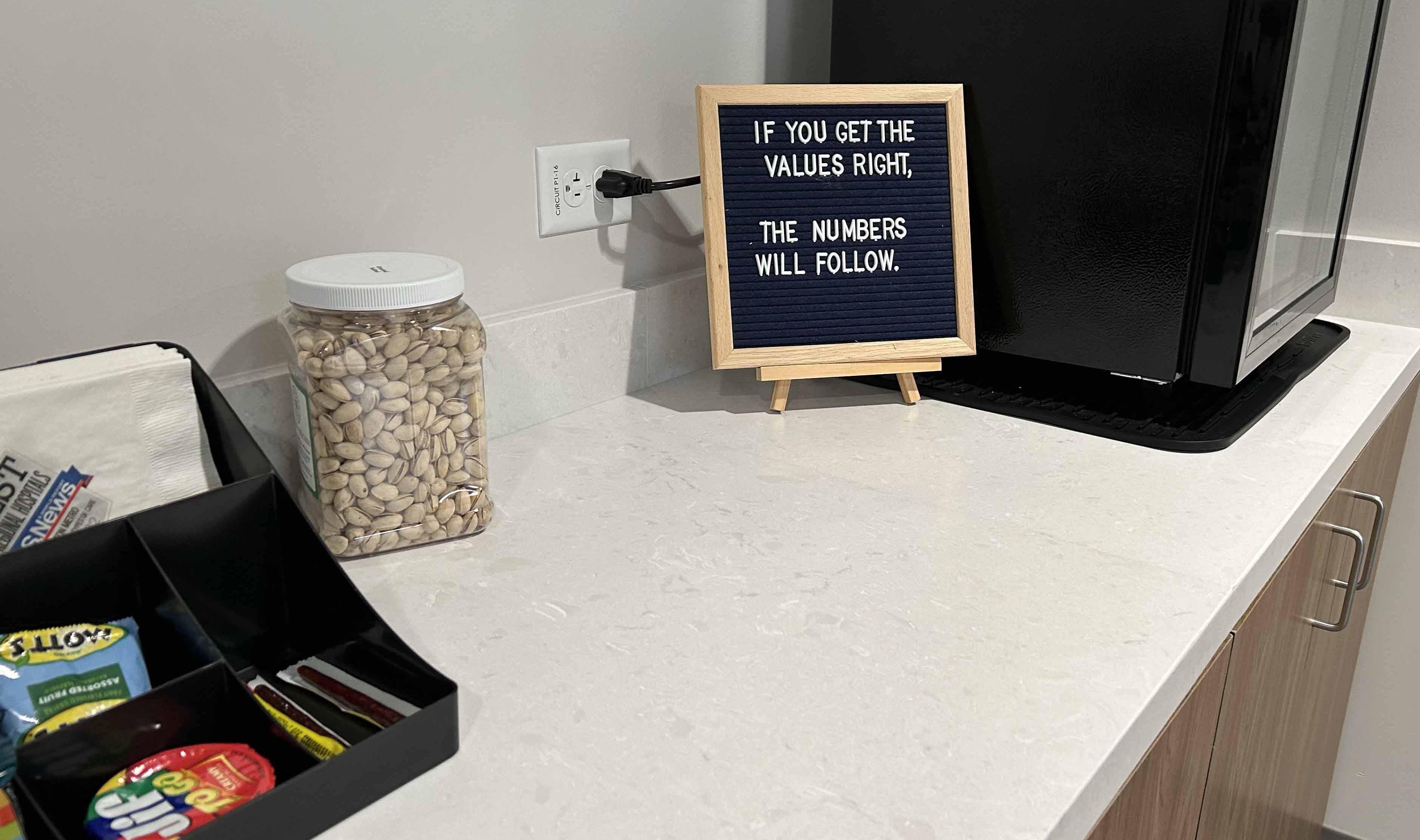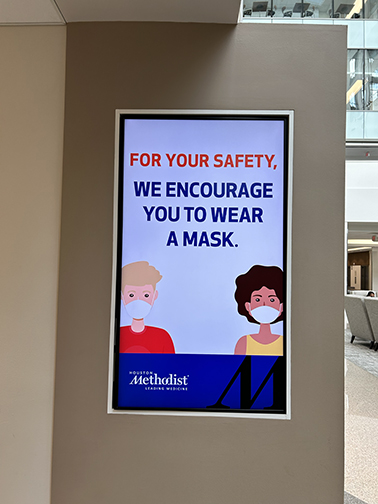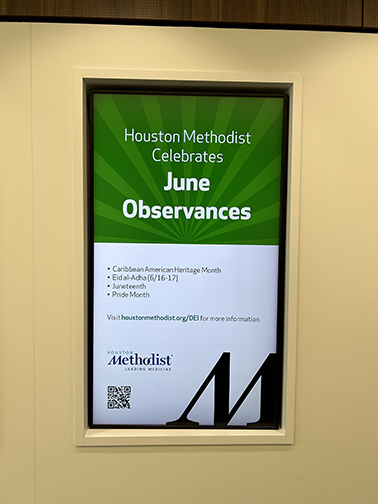
|
Where the Mission Meets the Margin
A Field Study of Organizational Communication at Houston Methodist Hospital |
     
|
|

|
Where the Mission Meets the Margin
A Field Study of Organizational Communication at Houston Methodist Hospital |
     
|
|
 |
Justin Zamora was born and raised in El Paso, TX. He loves watching sports and spending quality time with family and friends. He is a former student-athlete at Southwestern University who will be graduating in August 2024 with a bachelor's degree including a major in Communication Studies and a minor in Business. Guided by strong communication skills and a genuine passion for leading others, he works to foster a collaborative and competitive environment where everyone can thrive. Post graduation, he will be working with Amazon as an Area Manager for Operations. |
During my week-long experience at Houston Methodist Hospital (HM), I was blessed enough to observe the behind the scenes of the #1 Hospital in Texas for Patient Care & Safety* (* - two way tie). I observed various aspects of organizational communication, culture, and structure. This report will delve into how HM is organized, its company culture, friction points, and their methods of internal and external communication. My research and observations were conducted at both the Houston Methodist Willowbrook (HMWB) and the flagship Houston Methodist Hospital in the Texas Medical Center (HMH), providing an extensive view of HM's operational dynamics across its venues.
How is HM Organized?
Houston Methodist Hospital operates as a multi-layered organization that has several departments and specialties. This complex corporation has departments that have a clear hierarchy and specific roles that are designed to ensure smooth and cohesive operations. Here are some of my key observations:
Departmental Coordination
In a healthcare setting as big as HM, there needs to be coordination between all departments and all locations in order to ensure that everything runs smoothly. Each department has its own set of defined protocols and responsibilities that they must operate under. For example, the marketing and PR teams at Willowbrook (HMWB) must work closely with Corporate to ensure that there is consistency across all market areas while also tailoring to its local community. There are editorial style guidelines that are sent out from corporate to ensure the consistency of all work created by marketing departments. Because of this guideline, there is a uniform look to all media and editorial posts across all parts of the system.
Departmental coordination is a must for achieving organizational quotas/goals and for maintaining efficiency. When there are various departments working harmoniously towards a common goal, there needs to be clear and concise information being passed from one to the other. By allowing different departments to work closely together each and every day, there is little room for confusion and error. In an environment like HM, where time is of the essence, you better believe every second counts.
Centralized Decision-Making
In a centralized organization like HM, all significant decisions, especially those related to major initiatives and change management, are centralized. This means that communication and decision making flows in a waterfall-like manner, from top-down. In most cases, corporate approval is necessary for crucial actions such as advertisements and signage. This model of organization ensures there is consistency across all eight parts of HM's system. There is a con, though, because with the top-down protocol in place, the implementation process can be slowed down if there are disagreements within the hierarchy.
Our team and Southwestern interns with Dr. Stephanie Bruce at the roll-out of the Safety Sam campaign. Photo courtesy of Dr. BruceA great example of this can be seen at HMWB where there was an ongoing 12-week safety initiative being implemented by Dr. Stephanie Bruce, one of the doctors at HMWB who was leading this initiative in her role as Assistant Chief Safety Officer. The overall program was called "Excellent Communication for Exceptional Patient Care," and Dr. Bruce worked to make the theme engaging by connecting it thematically to summer, calling it "Summer Fun with Safety Sam," complete with beach-themed props and a person dressed up as Safety Sam in a giant unicorn mascot costume. Located below is an image that includes Southwestern University students, Dr. Bednar, and, Dr. Bruce, all pictured at the roll-out of the campaign at a Stand-up.
Dr. Bruce wanted to have different people take pictures with Sam to show widespread engagement with the initiative and share them on social media and on MADI boards throughout HMWB, but she was told that HMWB would be allowed to showcase Safety Sam only in internal communications, but not any further than that. Why is that? Well, she received pushback from two different groups for the same basic reason. Many of the charge nurses thought that Safety Sam was diluting a serious situation with humor and or a not so serious theme. The Marketing department thought the same thing, and was especially concerned that it might challenge the serious tone of their brand. This meant that Safety Sam could not be displayed on any pamphlets, signage, or MADI boards that were visible to the public eye at HMWB. However, he does have clearance to be in Willowbrook Weekly, the newsletter that is sent out weekly to all HMWB employees.
I thought it was significant not only that the incident reinforced uniformity and control, but also that each of the different stakeholders felt empowered to speak up to uphold the mission and values of the organization, and that through deliberation at a set of meetings, a solution was reached that everyone could get behind.
Company Culture
HM's company values and culture are deeply rooted in its mission. Their culture emphasizes an approach that revolves around the patient and promotes excellence, inclusivity, and compassion. Here are some of the key cultural elements that I observed:
Four Corners of Compassion
Love, Caring, Prayer, and Respect are fundamental values that are integral to daily operations, guiding how staff interact with each other and patients. This is clearly evident in their practices such as starting their daily stand-up meetings and some of their huddles with a prayer and by having a chapel that is open 24/7, while also having a prayer room for Muslims. By incorporating these values into daily operations, it shows that there is a commitment to holistic care, addressing both emotional and physical needs.
ICARE Values
Integrity, Compassion, Accountability, Respect, and Excellence are emphasized across each and every department, fostering a supportive and close-knit work environment. ICARE values a related set of "Culture Agreements" are part of stand-up meetings and are reinforced for all staff to use in their daily activities. By embedding these core values into their work environment, it helps all the staff reinforce behaviors that are desired, ultimately creating a cohesive organizational culture.
Diversity, Equity, Inclusion, and Belonging (DEIB)
There is a compelling focus on DEIB, including specific sections in the weekly newsletters sent out by HM and initiatives to support a diverse organization. Notably, many department heads and staff members in positions of authority are minorities, further reflecting the hospital's commitment to inclusion. By making DEIB a priority at HM, not only does it create an environment that is more equitable, but it also enhances its overall adaptability and effectiveness.
Friction Points
Although HM is a robust organization and has a positive culture, there are several friction points that HM can address. Here are my observations:
Communication Overload
HM relies heavily on email communication, but many of the people we talked to say that because of the overall pace and diversity of their work tasks, they are rarely able to keep up with email. Staff members face a barrage of emails each and every day, and this can dilute the effectiveness of critical alerts and messages. Communication overload can lead to increased stress among HM staff and it can also lead to decreased productivity. HM can avoid this and manage overload effectively by prioritizing emails/messages, using different channels of communication for various reasons, and by setting guidelines that are clear and concise.
Change Management
Communication around change is an area that the hospital can improve on. Some staff expressed that changes are sometimes communicated poorly, leading to confusion and errors. With such a robust amount of communication modes at the hands of HM staff, and the volume specifically of email, some change emails/messages are missed. I noticed this issue being highlighted in discussions with staff, and even experienced it firsthand when a stand-up meeting we were scheduled to attend was changed to be held virtually and we were there in person with fellow staff members who did not see the last-minute email informing them of this change. So what needs to happen to avoid this? When these change notices do arrive, they need to be clear, concise, and communicated well in advance. The following questions must be answered within the change notice: Why are the changes happening? Who do they affect and how? Where are they happening? By answering those questions in the notice, you inform the staff of the changes but also engage employees and address any of their concerns to reduce resistance to change.
Internal Coordination
The departments at HM are well-coordinated, and they do a great job in inter-departmental communication. During emergencies, all departments have to be on the same page and this is crucial. Regularly scheduled inter-departmental meetings improve communication and coordination. In high stakes environments like hospitals, daily stand-ups and communication between departments is a necessity.


MADI boards at HMWB. Photos by Bob BednarInternal Communication
Internal communication at HM is multifaceted, taking advantage of various channels to ensure coordination and information distribution. Here are my key points:
Email Communication
This is primarily used for important announcements, daily updates, and hospital coordination. Although this form of communication is effective, as mentioned earlier, it ultimately contributes to communication overload as it forces everyone to figure out their own methods for sorting emails into must-read and may-ignore. If HM were to implement internal social networks (such as Slack or GroupMe), it could help reduce email dependency and enhance communication efficiency, though some organizations find that adding these networks creates more communication redundancy instead of less.
Stand-Up Meetings
Daily stand-up meetings and huddles are held across the different departments to discuss patient status, any critical issues, and daily operations. These huddles also cover key performance indicators on patient traffic flow, departmental updates, and interdepartmental and inter-level escalations.
Newsletters
Weekly emailed newsletters provide updates on DEIB initiatives, employee achievements, operational changes, events happening in and around the hospital, including the cafeteria menu. There are efforts made to ensure that these newsletters are comprehensive and consistent while also not requiring too much time to read. Newsletters are valuable tools for internal communication. A great newsletter spreads information that the reader must know, creates a sense of community within an organization, reinforces a singular authoritative organizational voice, and boosts employee engagement.
Digital Signage and Alerts
Electronic boards (MADI Boards) and TV displays are used in on-stage areas to communicate important information for patients and employees to read. They are also used to communicate patient transport information and other critical updates in real time off-stage. This helps get news and info to the viewer efficiently and quickly. You will see digital signage being used in healthcare settings to provide real time updates and critical information, further improving patient and staff experience.
External Communication
HM's external communication is designed to engage the community and build brand awareness to attract new customers through numerous strategies and channels. Here are my takeaways:
Marketing Campaigns
The Marketing department employs tiered marketing strategies, with Tier 1 focusing on overall brand strategy and high-reach channels such as commercials, while Tiers 2 and 3 target specific specialties for their physicians. These marketing plans are developed annually, starting in June and finalized by November to be released early January. By breaking their strategies into tiers, it allows for organizations to allot resources effectively and eventually target specific audiences with tailored messages.
Social Media and Online Presence
There are significant efforts made by the Social Media and Marketing teams to provide a strong and unified online presence through various social media outlets, third-party sites such as WebMD, and search engine optimization. The Marketing team focuses on testing new outlets to spread their name, this includes TikTok and Snapchat, to reach wider audiences. Social media is a powerful tool that can be used for healthcare marketing. This type of marketing is needed because HM has made the strategic decision to reinforce their overall brand instead of marketing individual physicians in all their external communications.
Community Engagement
HM engages with the Houston community by hosting events, creating sponsorships with big name brands, and by strengthening direct-to-consumer relationships. All of these efforts are tailored to meet the specific needs of the local population. For example, HMWB sponsors and provides physicians/trainers for varsity football games for 10 school districts in their service area. By doing so, community engagement helps build rapport and trust with the local community. This creates a strong reputation for an organization and it fosters long-term relationships.
     
|
|
Design © 2024 by Bob Bednar and Alexa Delenela
Contact: |